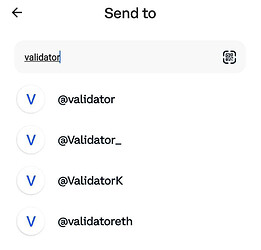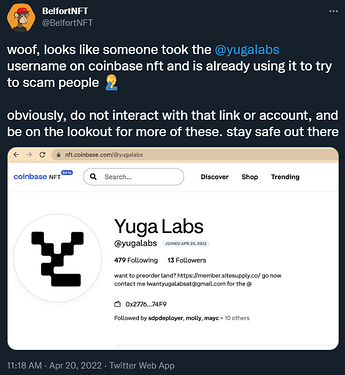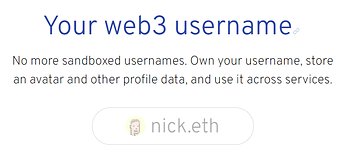The new Coinbase NFT site was brought up in a different thread, and I noted that it appears to just use its own private database of usernames (I’m guessing the same system from Coinbase Wallet):
And this is already leading to new scams:
Now there’s an interesting new wrinkle in the story:
If Coinbase is rolling out ENS subdomains, I’m assuming their existing database of Coinbase Wallet / Coinbase NFT usernames will just be converted into *.coinbase.eth subdomains or something like that?
What’s most interesting to me, and I didn’t realize this before about ENS subdomains… is that this doesn’t appear to cut down on impersonation scams, but might even help such scams…
Now you’re just creating another new popular namespace that scammers can squat names in, like that example from above with @yugalabs on Coinbase NFT. Even if that will actually turn into yugalabs.coinbase.eth in the future, I can almost guarantee you that the average user isn’t going to know that (especially if Coinbase’s website still just shows @yugalabs). They’re still just going to think that’s the official account.
Like what if twitter.eth was given to Twitter and they start allowing people to register subdomains, and have some kind of first-class integration for those subdomains on Twitter profiles? Now I can go and squat on vitalik.twitter.eth and trick people into thinking I’m Vitalik!
For the vast majority of subdomain systems I’m sure this won’t be an issue, but it’ll definitely be an issue on those few ultra-popular systems (like perhaps *.coinbase.eth). Unless the owners build some sort of restrictions on which names can be registered.
For example, maybe only the owner of domain.eth can claim domain.coinbase.eth or something. Similar to how claiming DNS domains works on ENS. That way at least the owner of a .eth name wouldn’t need to worry about someone claiming their name in some popular subdomain namespace and scamming others with it.
Such restrictions would not be on the ENS protocol side but rather built into each subdomain registrar obviously. If anyone is working on or is aware of such subdomain registrars, I would definitely hope that they include restrictions like this to prevent scams. Otherwise I fear that ENS subdomains could have a more harmful than helpful effect on the web3 ecosystem…
Thoughts? Am I overthinking it? @zadok7 and I deal with a lot of scam-related support tickets, and I’m just envisioning and dreading the new wave of ENS scams that could arise once L2 subdomains are possible. 


 scams. Although, I’d imagine that Coinbase is exposing itself to a lot of legal mess if it doesn’t police *.coinbase.eth. Someone scamming as vitalik.coinbase.eth lands coinbase.eth in trouble.
scams. Although, I’d imagine that Coinbase is exposing itself to a lot of legal mess if it doesn’t police *.coinbase.eth. Someone scamming as vitalik.coinbase.eth lands coinbase.eth in trouble.